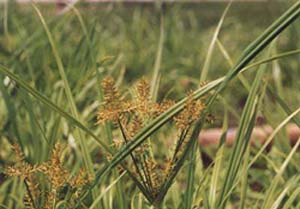


Stop 4: Sedge Meadow

Sedge meadows are characteristic of wetlands found in Indiana. These areas are usually covered with water in early spring but are much drier during the other parts of the year. Although the soil is not saturated, it still must be quite moist in order for the sedge grasses to thrive. The sedge meadow's peat soil stores this needed moisture during dry spells and can also function like a sponge in periods of high rainfall.
|
The Loblolly Marsh contains several sedge meadows. These meadows consist mainly of sedges like hummock sedge (Carex stricta)and wool grass (Scirpus cyperinus). Other common plant species in the meadow include blue vervain (Verbena hastata) and marsh milkweed (Asclepias incarnata). The thick vegetation provides excellent habitat for ground-nesting migratory birds as well as for smaller animals and insects.
The managers of Loblolly Nature Preserve use fire to to prevent woody plants from overtaking the sedges that the animals depend on for cover. Like the tall-grass prairie, sedge meadows like the one found at the Loblolly Marsh are accustomed to fire.
Links:
The
Nature Conservany: Wetlands-Sedge Meadow
Wetland
Plants
Sedge
Meadow
Sources:
Eggers, Steve D., and Donald M. Reed. 1997. Wetland
Plants and Communities
of Minnesota and Wisconsin. St. Paul: U.S. Army Corps of Engineers, 1998.
Northern Prairie Wildlife Research Center Home Page. 10 Dec. 2003 <http://www.npwrc.usgs.gov/resource/1998/mnplant/mnplant.htm>.
Twin Groves Museums in the Classroom Team. "Sedge Meadow." Kildeer Countryside Virtual Wetland Preserve. 1998. Twin Groves Junior High School, Buffalo Grove, IL. 10 Dec. 2003 <http://www.twingroves.district96.k12.il.us/Wetlands/Sedge/Sedge.html>.
The Loblolly Virtual Nature Trail was created as a part of the Our Land, Our Literature website.
